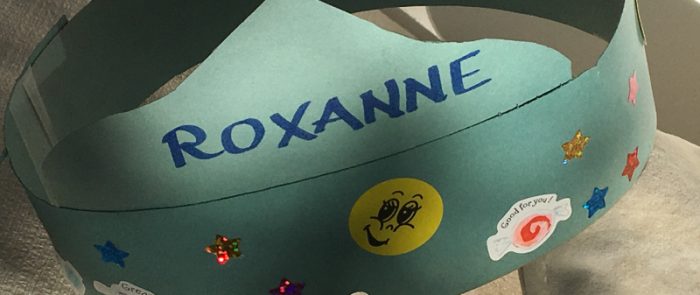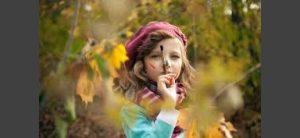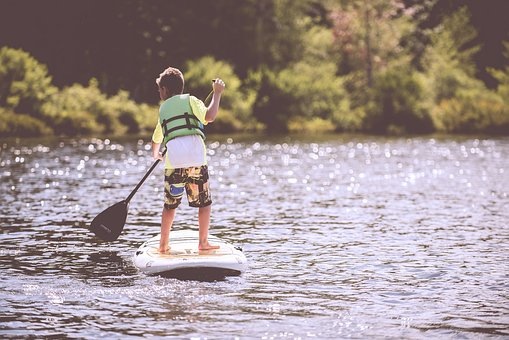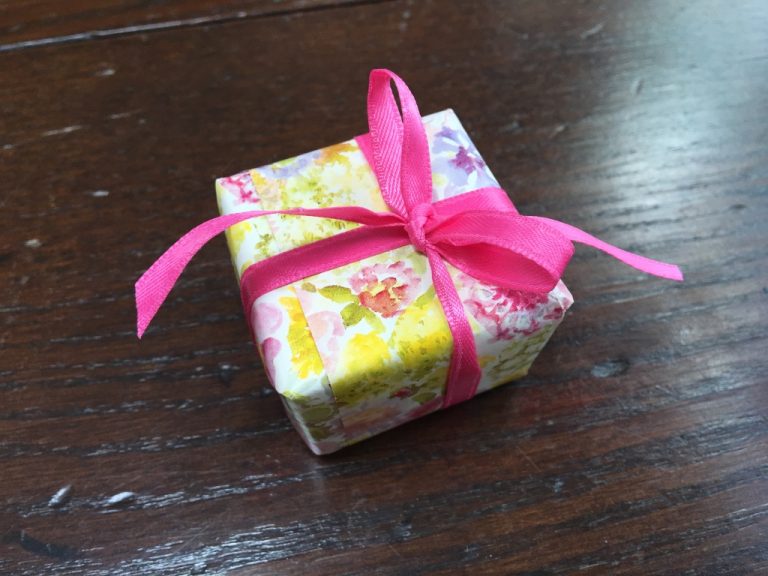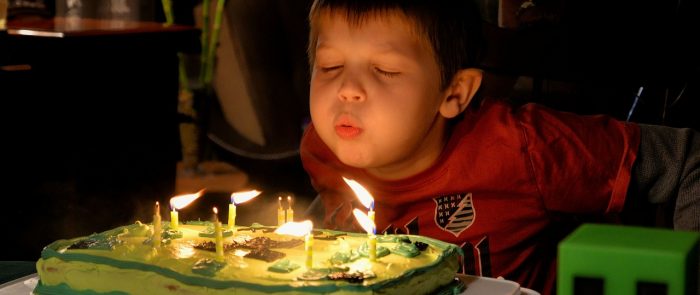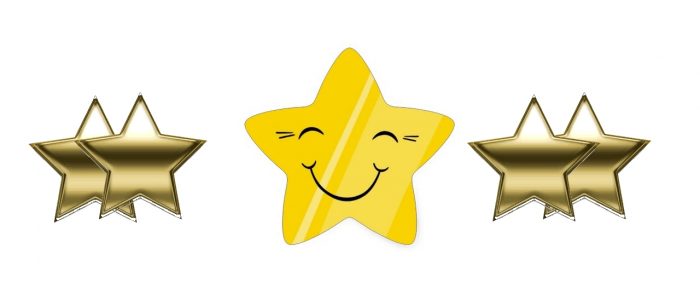To see a world without anger, hatred and violence, we must cultivate loving kindness at home within your family by […]
Archive for the ‘Blog’ Category
As a little kid, I loved riding, like crazy, my new bike or endlessly exploring my backyard for the tiniest things and building imaginary worlds; I played for hours on my own or with others. But, I want you to know that when I was in kindergarten, I became stressed! Yup!
On the first day of school, all the students received personalized crowns to wear- clever way for teachers to learn our names! Anyway, as the week progressed, our crowns were quickly filled with stars and stickers for good work and behavior!
But this one day, I turned around in my seat to answer a question of the girl behind me and the teacher said, “Roxanne, you come up to my desk right now! You were talking and you know you are not supposed to talk during quiet time. Give me your crown!” She took my crown and punched a hole right next to my name!
I was shocked and shamed! I don’t remember if I cried right then but I know I balled my eyes out when I got home and told my mother all about it. She was outraged and marched right to the principal.
…The next day, my crown was in my cubby, where it always sat each morning as we started the day. A big colorful sticker covering the hole. But I never forgot that underneath-there was a hole in my crown!
Has your child had an incident like this? Children are emotionally impacted by teachers, parents and caregivers. And the key ingredient for resilience is the strong attachment bond with you.
Typically, I hear parents use mobile devices to calm their child. But, no distraction away from the issue will build effective strategies for your child to handle challenging situation constructively.
I can teach you easy to apply mind/body techniques to start strengthening the connection with you and your child in a way that builds these sills in social emotional learning that are necessary for academic success and positive relationships with oneself. (You can download the technique PDF at the bottom of this page.)
My second example of the impact of learning on a child’s self-concept happened in elementary school. I experienced anxiety, particularly learning to read and taking tests. I did not understand why I got so nervous. All I knew was that my brain was blocked and I could not retrieve the answers I needed.
Years later at Harvard Graduate School of Education, my studies about learning and the brain, revealed the reasons. I struggled because the neurochemical pathways were tangled and had to be untangled. The emerging field of psychoneuroimmunology provided evidence based research about the interrelationship between our brains, emotions, nervous system and health.
In short, our emotions effect our thinking and behaving. It’s as if the doorway to learning is closed. And the way to open that door is by eliciting the relaxation response.
The Relaxation Response (RR), is a term coined by Harvard cardiologist, Herbert Benson, MD who noted that not only will the RR completely reverse the stress response by lowering blood pressure, heart rate, respiration and your overall metabolic rate. But it improves concentration and focus, increases recall and the ability to problem solve more creatively.
If you remember in my last email, I reported that one of the keys to managing our emotions is flexible thinking. Practicing relaxation techniques will allow you to open the doorway to your untapped brain potential.
Further more, when a young child or student feels good about him/herself, the doorway to learning stays open. HOW?
Just the simple act of a teacher positively greeting your child by his/her own name each morning as school begins, readies him/her emotionally for learning that day.
This is why it is not how much a teacher can teach your child but how the teacher makes him feel about himself that makes the difference.
What saved me that day I got the hole in my crown was parents who knew how to remind me of my true identity and significance. They offered empathy, stood up for me and most importantly conveyed the sacred self to me everyday.
“You are a beautiful child of God- you are good. You are love and you are loved.”
You cultivate resilience in your child by introducing them to their sacred self.
I tell you my story because this is the reason I am passionate about designing programs and teaching children:
1. to know how calm down and focus
2. to know their true self, the sacred self.
The true self which is Love, Joy and Peace.
SIGN UP for your FREE Download of Mind/Body Relaxation Activities for You & Your Child or VISIT www.drroxannedaleo.com comment or ask me about your challenge.
“I help stressed, anxious children calm down reduce their anxiety with natural methods so they can improve their focus and concentration, do better in school and just be happier overall.”
By Dr. Roxanne Daleo
- STEP 1 – Set the conditions for calm and creativity
- STEP 2 – Focus your breathing long and deep, slowly and evenly
- STEP 3 – Take out your seeing mind, put away your thinking mind
- STEP 4 – Draw, paint or dance your inner visions through your imagination
STEP 1 – Set the conditions for calm and creativity
You need a quiet space. Preferably, play soothing music using a guided imagery relaxation journey audio program visit:www.drroxannedaleo.com and pick one!)
Using mind/body techniques combined with the expressive arts fosters calm and creativity.
STEP 2 – Focus your breathing long and deep, slowly and evenly
Across cultures and for thousands of years, the breath has been central to calming the nervous system through practices such as Tai Chi, Qi Gong, yoga, Mindfulness and guided imagery relaxation. In order to learn to control your arousal system, you must learn to control your breathing. There is a clearing space in the breath. The more flexible your breath, the more well-regulated your metabolic and heart rate. Repetitive, rhythmic breathing turns the volume down on the hyper-arousal of the autonomic nervous system and allows the body to shift into deep rest. This shift is essential for becoming calm, feeling safe and enhancing creativity.
Creativity is stifled by fear. Children love to use their imagination. Learning about their inner self, the inner landscape is empowering.
STEP 3 – Take out your seeing mind, put away your thinking mind
Vision is a gift. My grandmother had vision; she saw herself as a world traveler and did indeed travel the world. When I was four years old, there I was in New York harbor, waving bon voyage to grandma as the Captain of the Q.E II (Queen Elizabeth II) ocean liner smashed a bottle of champagne over the bow of the most massive, stunning ship I had ever seen! This was my first glimpse of creative manifestation. Little did I realize then, the following year when I was five, my grandmother would take me on her next destination to Venezuela, South America! My older sister got to accompany my grandmother to the Orient! Quite amazing when I think back on it now. I never knew it took such vision, courage and creativity to plan to be a world traveler!
This is the thing about the creative process, you start with some paints or clay and you begin to train your brain to envision and create, create, create! Let’s look at that word: envision = in vision, inner vision. Without it our spirit dies. We must take out “our seeing mind” and put away “our thinking mind”. Our seeing mind is our insight, the sight in our heart. Our thinking mind is often taking our attention to our daily uncontrolled thoughts. Vision, on the other hand, is intentional. You are deliberately focusing on seeing a vision of something you want to create.
STEP 4 – Draw, paint or dance your inner visions through your imagination
Today, I realize just how much vision my grandma had to become a world traveler because she was not a wealthy person. She came from humble beginnings but she was a hard worker as a seamstress. Her work ethic allowed her dreams to become reality. If we want our children to develop their creative genius which is innate, we must set the conditions for exploring inner visions and dreams. I started in early childhood while watching my grandma cutting patterns for coats and dresses, sewing on a machine then taking the left over material scrapes and crafting a hat or belt. She’d hand me the pieces of varied fabrics and say- “You make something!”
This is how you begin. You connect side-by-side in a peaceful place in your home. It could be a sewing or art corner. And by you sharing something you love to do, your child picks up your vibes!
Give your enthusiasm to create something from nothing to your child. And watch what happens!
Cultivating Happiness in Your Child and Yourself
The 3-Step Process
by Dr. Roxanne Daleo
On any Saturday afternoon, the Boston Children’s Museum and gift store is bustling and busy! That’s how it was the day I visited. I saw moms and dads with their children and grandparents on a special outing with the family.
A little girl who looked to be three and a half was in front of me, I could hear a voice from a short distance say, “Honey, would you like this cute, stuffed bunny or the mermaid doll?”
No response came quickly from the preschooler; she just kept looking around at the many choices of colorful objects everywhere. “Come on now, Sweetheart, what do you want?
Again, the little one with glazed eyes and speechless continued to scan and touch every row of
hanging items on the racks in front of her. Her mother in earnest says, “ OK, well
maybe you’d like this set of crayons? Or this book?” The mother opens to the first page and starts reading to her daughter amidst the chaos. The young girl, staying with her mission, systematically moves unhurried along the wall of books. Her mother, now with a sense of urgency in her voice says, “I really want you to be happy!” No response from her daughter.
Now it was a good thirty minutes or more that passed, no kidding! The mom continues,
“Does this tiny bear make you happy? Finally, the child nods, yes. “Are you sure? Because I want to make you happy! The child didn’t appear particularly thrilled with the little bear but took her mother’s hand and walked to the register. As they walked out the door past me to the coffee shop Au Bon Pain I heard the mother’s voice fading in the distance, “Sweetie, would you like a nice bread?
I wish I could say this was unusual, but the truth is, it happens all the time. I was amazed at this mother’s strong effort to do what she thought would make her child happy. Is that wrong? No, but it puts much emphasis on external things as the key to happiness, doesn’t it?
We all want to be happy. In fact, many parents and kids I counsel come to me to reduce anxiety and depression. Motivated by their desire for happiness in themselves and their kids, a parent will confess that their “go to” method for motivating their child is bribery: “if you finish your chores, you’ll get allowance at the end of each week”
Bribes do not work because they are extrinsic in nature rather than intrinsic. Often changing your child’s behavior but not necessarily for the better. This revelation can be a real eye-opener, especially when you can see how your child becomes more demanding, inflexible and intolerable after bribing is employed.
For lasting results and life long happiness to be achieved, there must be a SHIFT from outer incentives to inner self-motivation. Here are 3 ways to cultivate happiness in your child and yourself
1. Giving a Toy vs. Enjoying Activity
Know the distinction between immediate gratification of giving your child a toy (mobile device, etc.) and doing an activity that brings pure joy. It is the feeling of joy that motivates from within your child. The act of doing something your child enjoys alerts him about how to “feel happy” without anyone bribing him.
2. Complimenting vs. Inspiring Belief in Self
Know the distinction between giving your child a compliment and having him feel pride in a job done well or in a skill mastered through practice such as piano, skiing, etc. When your child finds strength deep down inside of himself, he learns he is more powerful than he initially realized.
3. Comparing vs. Feeling Good About Who He Is
Know the distinction between letting your child compare himself as “not good enough, smart enough,” etc. versus recognizing his inherent gifts and goodness. Tell your child you are born with certain talents or gifts. Ask him to tell you what they are. Your child feeling good about who he is comes from knowing he matters. When a child knows his identity as a significant member of the family, his feeling good about himself grows. Further, how he is as a friend, such as being helpful, kind, caring also fosters inner contentment.
Cultivating happiness comes from understanding the inner child life process and promoting that.
In my work and play I enjoy hand crafts and expressive artistry. One of my favorite places to go for inspiration is Michael’s Craft Stores. I can always find a wide array of color, forms, glitter, ribbons, paper and most importantly, my very own imagination, right there in the store with me. I like to check out the scrapbook section for new items, because I’ve known the value of journaling for myself and in working with children. I learned from my mother – a master teacher of creating beauty, something from nothing, inventions and gifts.
Perhaps over the years of having daily opportunity to “tend to,” to “minister to,” to be “in sympathy (symphony, harmony) with” these charges of children and families, I naturally evolved
my own awareness of the preciousness of one’s life and not to waste it.
As a Creative Arts Therapist, I am drawn to the stickers, lettering and quotes you can purchase and paste into a scrapbook or on posters and wall banners. One summer on my birthday I had just
come through major eye surgery, and I was looking to celebrate my birthday in a special way with loved ones. There on the shelf I saw a stick-on decal which read: “Every Day Is a Gift, Untie the
Ribbons.” Wasn’t that perfect? Thus was my synchronicity, or “God wink,” as my family would 1 refer to it. I thought to myself, “What a beautiful way to inspire the preciousness of one’s own life.” This got me reflecting, feeling, and behaving with renewed appreciation for “what is,” and for all my blessings. That might sound trite, but it’s deep if you truly get the meaning of the words.
Months later, while counseling a family who lives in town, I was asked. by the parents of Cynthia, a nine year-old, how to handle their daughter’s regular bursts of rude behavior and know-
it-all attitude. They reported that Cynthia upset her grandmother, an accomplished artist, who came to sit with the girls for a couple of days. She harshly told her grandmother she knew nothing about color and the art project for school, and to “bug off.” Another incident occurred the night before Cynthia’s piano concert when her mother, having been a Iulliard music student, offered a few practice techniques. Cynthia’s retorts were quick and hurtful.
“She is not even open to a suggestion,” her mom would lament.
I understood. I felt June’s anguish and shame at having a daughter who came from privilege to be so disrespectful. “How does this happen? I’ve tried in many ways to reach Cynthia, but with no success,” said her mom.
One of the reasons I am able to “reach” kids is because I am one – forever young! A‘solution might pop into my head that is literal, light-hearted, in tune with a kid’s way of thinking, and smack~ing of attitude. In short, a “one picture is worth a thousand words” lesson. The following technique came to me as so many do, while having a normal day. As I was passing through the dining room where we had left birthday decorations up on the walls, my eyes looked upward. Remember the banner “Every day is a gift, untie the ribbons?” I suddenly got an idea for June.
I called her and said, “June, the next time Cynthia is rude or disrespectful to you, I’d like you to try something new in response to her. Are you interested? “Yes, definitely,” she said. I instructed II her get an empty jewelry box and place a heart inside the box. I explained that it could be cut out of pink paper or made of clear glass or a pink stone. Luckily, lune had a rose quartz crystal heart. I told her to place the heart on a piece of cotton inside the box, then wrap the box and tie a ribbon around it, just as she would with any gift for Cynthia.
l I said to June, “The next time you offer Cynthia a suggestion that she reacts to harshly, don’t l SAY anything. Motion to her to sit shoulder-to-shoulder with you at the kitchen table, where you
have placed the little box in front of you. Be sure she is watching as you whack it enough to shoot across the table. Then retrieve it and put it in front of Cynthia and say, ‘Cynthia, when you refuse to stay Open to suggestions, which I offer with good intentions, it’s like you bat away this gift that is being offered to you, rather than seeing it for what it is, a gift which you can open and see what’s inside. Now, Cynthia, I’d like you to sit with it, hold it, open it and see what’s inside.
As instructed June did this with Cynthia. Cynthia recognized her mother’s gesture as a gift. June could see Cynthia’s physical stance softening as she opened it, and received her mom’s heart. She was able to see her mother’s intention. Cynthia smiled at June, then took off to show her younger sister what had happened.
Just as opening the jewelry box unleashed a new way of thinking for Cynthia, so too can stress – when handled positively – unleash healthy ways of coping with problems.
Stop-Action, Reflect and Reframe
In the example “Every Day is a Gift, Untie the Ribbons” we inspire our children to realize the impact of their behaviors. We also raise their awareness of the preciousness of life- their own
as well as another’s. We are cultivating empathy.
Whether the problem issue is inflexible thinking (a kind of know-it-all attitude) as was the case of june’s daughter, Cynthia (not their real names) who had regular outbursts of rude behavior
or the problem is mean, hurtful physical pushing away, both are unskillful ways of handling intense emotions.
However, if a parent is alert to the situation, these situations can become powerful teaching opportunities, rather than impulsive incidents when we ridicule our child for unacceptable behavior.
Intense feelings like anger, jealousy, meanness, and unkindness sometimes surface in our children. How we handle these episodes can lead to new skills or cause more resentment and even hate.
This is why I urge parents to be alert to the teaching opportunity here.Then you can, literally, “stop-action, reflect and reframe”.
The reframe for Cynthia’s pushing away the well-intended advise was illustrated, concretely, to her using a tiny gift box wrapped in a ribbon with a glass heart inside. The impact of her
behavior was felt as the rejection and hurt she so carelessly dished out.
“One picture is worth a thousand words.!” Further, showing the feeling in action, can be more powerful than telling about the feeling in words.
The key here is that emotional intelligence is developed when awareness is raised. The impact of a negative behavior is felt by the one who gave it out, previously, without consideration or
deep empathy. This is how we model right action, I call, behaviorship and thoughtmanship.
In many cultures throughout the world, there are beautiful and healthful customs that we can borrow to relieve ourselves from the stresses of everyday life.
For example, the indigenous peoples of Canada, “leave worries in the basket” outside the door of their homes. They believe it allows for harmonious relations. I wonder if this custom could improve the atmosphere of conscious living for us and foster a more peaceful home life with our children?
Baskets abound this time of year for Americans, try keeping an empty basket at your front door.
Tie a ribbon on the handle, then using a marker in your own handwriting print on the ribbon: “Leave your worries in the basket!” No Easter eggs or flowers, please; this basket is only for the purpose of depositing worries. Just casually read the instructions to your child as you enter the house. Most kids will follow your lead and use their imagination to place a worry thought in the basket each day they come home and especially after school.
This practice is an emotionally intelligent process. It offers your child a concrete, tangible way to do 2 things: 1) Become aware of their “thinking mind” which is the start point for stress
and 2) Offers a solution that empowers your child to help himself.
This practice is a good introduction to the mind/body connection. I began to understand the mind/body effect years ago when I was involved with the ground-breaking research in the emerging field of psychoneuroimmunology: the study of how our thoughts trigger a cascade of neurochemicals that directing effect our immune system, either negatively or positive. It all depends on our perception.
Yes, stress is a perception of threat to the emotional or physical well-being of a person and a feeling of inability to cope with the stressor. These were the key factors in handling the event or collapsing in on oneself.
In short, it is the meaning we give events and our perception of having the coping ability or not that makes the difference. This is why learning how to take hold of your thinking mind will help you and your child choose wisely the way to think about events and people in your lives.
Leave your worries in the basket – and choose peace instead of chaos.
What Do Humming, Whistling, and Blowing Out A Candle Have In Common
To Calm Your Child?
By Dr. Roxanne Daleo
The throat is the communication center of your body. Your throat can be used in verbal and
non-verbal ways: verbally as in speech, non-verbally as in humming.
Humming enhances your brain power and calms the nerves. Humming deeply, will create
more resonance. And creating more resonance generates the intention behind it. For example, humming softly, melodically in the ear of your child helps calm her. Whereas, humming in staccato (the musical signature of short, quick beats) or deliberate popping sounds can uplift your child’s mood from distressed to delighted.
Both kinds of humming is a kind of sonic meditation in which you vibrate! Literally, you vibrate your skull and brain with your lips closed. Doing this for about three minutes will put you into an altered state of consciousness and will transmit this trace-like state to your child which is very calming for both of you. Webster’s dictionary defines hum as “to run smoothly”. I love that!
This process has been well researched in the field of sound healing and it is called entrainment.
Entrainment is being in rhythm with our child, activity, surroundings and with the Universe.
Grandmothers singing lullabies and indigenous peoples using chanting and drumming knew
the power of sound healing. We can bring back these ancient practices for modern times as
we incorporate techniques for raising the resilient child.
Besides having the calming effect, it is interesting to note, that the humming vibration actually
wakes up your brain cells and makes you receptive to ideas and subconscious information. So if you want to tune up your brain, hum to yourself.
When you are attuned to your surroundings, you are able to pay attention to the vibrational nature of all life.
Let’s remember, in my last post, about the little 5 year old girl who said: “Mommy, I can’t catch
my breath! And mother responded in fear with “Do we need a trip to the emergency room?”
Now, what if, instead, the mother was able to use and respond with “spontaneous availability”.
The method my mentor, Tom Carpenter, referred to as moment-by-moment awareness to be available yet spontaneous.
Through this method, you are teaching yourself, first and foremost, how to be BOTH spontaneous and available. You do this by recognizing the fact that you can generate emotion
by choice.
Always begin by taking a few deep breaths before saying any words. Model this for your child
as the essential method of first aide.
Teach your child to connect with you for the purpose of calming down together.
We know from neuroscience when you exhale, as in blowing out a candle, the area of the brain
called the medulla oblongata triggers the “Relaxation Response” a process developed by Harvard cardiologist, Herbert Benson, MD. who wrote the New York Times best selling book by the same name. A must read if you want to be convinced of the beneficial effects for adults and children. I know how responsive adults were from my work as research assistant in Dr. Benson’s Mind/Body Clinic and positive results from my pediatric patients while at Boston Children’s Hospital with the gravely ill children in my charge.
Especially if your child is in a panic, you must use a strong signal to “reset” her. I do this by picking up my child, if she is small sitting her on my lap- if older, taking her by the hand to sit on the sofa. I have used my whistle or humming softly in her ear. Even more effective, is to place your child’s cheek against your mouth as if to kiss her but hum in staccato style “ma, ma, ma, ma, ma.” This sound is the first sound a child utters and causing immediate attentiveness.
Now, if it is possible setting up a calming space in your home ahead of time where you’ve placed a candle, is preferable. Light the candle and ask your child to blow it out. Then say, “Do it again, take a deep breath and blow out the candle!” Most children like this method because it has a positive association of blowing out candles on a birthday cake. I have also used blowing bubbles, especially effective outside.
This simple out breath, activates the brain and heart to bring about the relaxation response—
isn’t that amazing? Yes, and helpful for children in distress. Now let’s add some affirmations
you can say to yourself or with your child to change the atmosphere from upset to calm, from fear to love.
Looking her in the eyes say: “You’re ok, you can calm yourself.” Breathe.
Affirmations for Mother and Child
I am calm. You are calm.
I am safe. You are safe.
I am peaceful. You are peaceful.
I am love. You are love.
All is well.
And so it is.
Bring your intonation down as if to say “believe me!” And she will be reassured.
Remember, your children are not listening to you; they are feeling you!
And Why Gold Stars, Stickers & Bribes Do Not Work!
By Dr. Roxanne Daleo
Do you believe your child will become a leader because she makes straight A’s on her report card? Do you think a shopping spree at the Mall or date at the nail salon spa will improve her self-concept?
These and other questions came to my mind when I recently counseled parents whose 7th grade daughter compelled them to reward her for good grades. They told me each of them told their daughter how proud they were but also decided to award her ten dollars for each A; she earned five out of six subjects.
I ask you, do you think rewards will motivate your child toward such attributes as happiness,
pride and self-confidence? How do we cultivate prosocial behavior helping our child develop virtues of kindness, generosity and excellence toward themselves and others? Behaviors that foster the idea: there is value in aiming for the greater good of all concerned as opposed to self-serving, ego-centric behavior?
Currently the trend is more toward: “what’s in it for me?” mentality.
Do you notice the more you bribe your child, the more demanding, inflexible and intolerable she
gets?
I believe only someone who has a strong sense of self can lead others. A leader knows the greater good of the whole.
A leader has clarity and holds that clear vision in front of the group. A leader motivates others to work together as a “unit”, a team, a family. A leader has the ability to redirect the team when necessary in order to stay on course.
A leader has qualities of self-confidence, full self-expression and competence. Most important, a leader is capable of balance between esteem and humility.
The reason gold stars, stickers and bribes do not work is because these are based on extrinsic measures to motivate a child rather than motivating intrinsically from an inner drive. Extrinsic rewards depend on outside forces. Parents and teachers rule and hold the standard of conduct rather than intrinsic reward which inspires conduct for its own sake. This gives the individual a feeling of pride because he feels good about himself.
Does your child feel good about herself? How do you know? How do you keep that feeling going as your child meets greater and greater challenges?
To answer these questions, let’s get back to our 7th grader who received ten dollars per “A” on her report card. Don’t you know, she was thrilled! Then the next day, realizing she had a test in French which she only rated a “B” average, she decided to cut class in dance, put in more study time in order to ace her French test.
Am I the only stickler here or can you also see there’s something wrong with this way of thinking? You trade off one bad habit for another when you bribe your child to get an “A” at all costs. In fact, you are creating loss somewhere else. In this case, it’s a lack of respect for the commitment to the dance class and poor time management because of distorted priorities,
judgement is off which leads to dysfunctional behaviors.
Am I being too harsh? I don’t think so, the most powerful learning mechanism is consequences. There is a cause and effect to everything in life. It’s one of the laws of the Universe, called karma. Karma acts like a boomerang. What you put out will come back, so watch your back!
A good way to teach your child this principle is to take your child outdoors to your backyard, throw the boomerang at him and let him see it circle back to the thrower. Now give him a turn.
Amazing thing, really. I had a friend who’d go into schools with his “Boomerang Program” to
illustrate this very principle; his programs were quite popular.
Doing something for its own sake can be the reward when fostered early in childhood. I remember the story my husband told me about his boyhood family vacation. His father decided
to drive cross-country to visit the National Parks of America. Six kids and two adults piled into “Woody,” their station wagon; thrilled to travel for five summer weeks! He described the scene to me: My father would pull into a camp grounds and park the car. Dad never gave orders, he didn’t say a word. My brothers and I appointed ourselves in charge of pitching the tent while my sisters brought out the food, pots and pans and sleeping bags. Everyone seemed clear how they were to contribute to the
task at hand and we just did-happily-what had to be done!
Recently I had lunch with a prep school classmate. She described her situation with her son. She and her husband decided to enroll Tyler (not his real name) in private school for fourth grade because he was not being academically challenged in the public school. When they made the switch, Tyler rebelled. One night during the first week of being in his new school, his mother said she heard him sobbing from his bedroom. This distressed her deeply. So she decided to allow him to go back to his old school for a day to visit his buddies and check out for himself what he was missing. To her surprise, Tyler could feel the difference being with his old friends and it wasn’t the same as the year before. He said to his folks, he realized the new school was better for him and more challenging. Basically, Tyler had an inner instinct that helped him figure out for himself that private school was a good place for him. He made the adjustment and thrived there.
Both of these stories illustrate a young person’s intrinsic motivation.
Whatever your religious tradition may be, invoking a spiritual dimension (expressed as “God,” the “divine,” or simply “love” or “caring” or “goodness”) can be a powerful way of helping a child find a deeper appreciation of himself and others. For me, having been raised in the Catholic tradition, this was put in terms of “God” and the divine — but you can adapt this to whatever your own beliefs or traditions are.
“We all have the extraordinary encoded within us waiting to be released,” says Jean Houston
one of the most influential thought leaders of our times.
In some form and in your own way, remind your child that all the energy, all the power, all the wisdom of the Universe is inside you right now, you are made in the likeness of the Creator. Claim your spiritual ID.
I remember being told God is like the ocean, you are a spoonful of that “God-ness”
that “goodness.”
The first key to embracing ourselves as divine is through giving. St. Frances said “It is in giving that we receive.” To give: attention, a love note, a smile, a beautiful flower is a gesture of just connecting to the other person to be kind and caring. This is a lesson many kindergarden
children learn through the model set by a parent or teacher.
Self-esteem is the awareness of our innate goodness. It is present when a youngster feels good about himself. I foster self-esteem by helping children to see the impact of their kindness or
of sharing by bringing their attention to the face of the other child who they gave to.
I would say, “Johnny, that was very thoughtful of you to give a cookie to Mary. Look at her
face, is she smiling? “
Johnny says, Yes!”
I say, “And how do you think that made her feel?
Johnny says, “Happy!”
I say, “And how does it make you feel to know you shared your cookies with her?
Johnny says, “Good.”
I say, “Yes, you are a caring person.”
SUMMARY OF KEYS TO BUILDING SELF-ESTEEM
1.Catch your child in the act of being caring and sharing and you will get more of that behavior.
Slow down the action by deliberately bringing attention of the one who gave, to the expression
of joy on the face of the other. This is an emotionally intelligent way of building your child’s self-esteem. Self-concept grows out of the positive and negative experiences in your child’s life;
so be on the look out for the positive ones and amplify the influence these experiences have
by making sure your child “sees and feels” good about himself in the process.
2 The second key to building self-esteem is found when we model how to take our attention off our own problems and worries and focus, instead, on what we can do for someone else. The
simple shift in thinking about “the other” – our brother, our sister, allows the child to lose track of
circumstance and create an act of kindness and caring for it’s own sake. An act of caring done without any expectation of getting something in return.
3.Prompt your child by having a short conversation about ideas that would help the other
member of the family or would offer an expression of joy and love for them. When you take the time to do this, you help your child truly know their own identity and significance.
4.Tell your child about the day or night they were born. Children love to here about the excitement of their birth. Use storybooks like: “Knots On A Counting Rope” by Bill Martin, Jr. and
“On the Night You Were Born” by Nancy Tillman.
5. Tell you child how you named him and why. This kind of personal information gives your child
awareness of his identity and significance. Read this bedtime story: “The Incredible You” by Wayne Dyer.
By Dr. Roxanne Daleo
In my recent post, Go The Distance, I pointed out the importance of teaching ourselves and our children how to “stay with” a situation even when it feels hard, uncomfortable or boring. Some readers asked me how to begin.
Currently, many of us have been inadvertently filling our minds and hearts with the subtle energy of fear in all its forms- anxiety, pain, insecurity, anger, violence and the result is that we experience inner restlessness, unhappiness and become critical of ourselves and others.
The remedy is simple yet requires discipline and practice. A discipline to reverse the insanity of racing around like a nut to slowing down and resting in the moment! The true moment is the moment you connect with your awareness. The entry point: is your awareness that “I am aware.” The practice is your commitment to making the discipline a part of your everyday life. You do this so you can access dropping into the present moment when you need it most. Otherwise it remains illusive and inaccessible.
Slowing down seems so counter to the definition of success. Yet, “if in fact, the highest, most creative work is the work of consciousness, then in slowing down, Marianne Williamson, a thought leader, says, “we are not doing less, we are doing more…we are shifting from outer to inner.”
Rather than seeking approval or acceptance from our culture and peer pressure to determine who we are; we find our way though awareness. When we go within, in this way, we connect fully to our peaceful self. This is how we cultivate emotional maturity instead of blaming, worrying, judging and feeling frantic.
The key to establishing control is to spend a part of each day completely alone and enter the silence. Use the time to review your feelings and concerns; cultivate an attitude of non-attachment. You can accomplish this by the practice of paying attention to your thinking mind. This state of awareness is a way of being alert, yet you stay grounded. Holding this moment and this one, too. Slowing down everything from clock-time to your heart beats.
When you slow down to realize that the inner you is not your thinking mind. The inner you is the observer of your thoughts. You are actually learning how to watch your thoughts and feelings as they arise without getting caught in them.
Once you stop living in your thinking mind and start trusting the inner you, the peaceful you is a major turning point. The entry point is awareness. Close your eyes and say “I am aware.” Stay there. Use your determination, your intention to turn away from the day and bring your attention inward to your breathing. And breathe fully, slowing, naturally. When you do, you’ll notice that your peaceful self is always there even though you may go through much of your day out of touch with this peace. From your quiet mind, your intuition comes forward, your creativity comes forward.
Only through this entry point of awareness can you become ready. And when you are ready, you can take advantage of situations as they arise like the last few seconds of a football game. Because you’ve trained yourself to concentrate, focus and be aware. Perseverance allows you to hold on while the universe delivers the opportunity for a miracle—perhaps it’s a miracle catch!.
The Practice of Awareness Exercise:
Now, reread this article. Notice your reaction to this suggestion to reread this article slower than you did before, half the speed as before. Any thoughts come up, like “ I don’t have time”— “I have so much to do.” How can you be aware of your self when you are constantly future oriented- “I need to go here, I need to go there”… Slow yourself down enough that you still your mind. Slow down so that you have accessibility to the entry point of awareness. Discipline yourself to come into the present. Remember, the thinking mind always wants to keeps you busy, out there, far from your treasure within —inner peace.
Cultivate Healthy Happy Self-Esteem
“The Time Travel Technique”
By Dr. Roxanne Daleo
Have you ever heard or had someone say to you, with good intentions of course, “how can you be so dumb as to…!”
Educational social psychologist, John Gottman’s research on the impact of criticism reports that five positive to one negative criticism mars the individual’s self-concept. In other words, it takes five times as many praises to one critical comment to restore a person’s esteem. That is why the old saying which my mom often referred to is so true: “you catch more flies with honey!”
You can capture your child’s heart with sweetness and honey words of praise using the following. “The Time Travel Technique” illustrates a clever way to anchor your child’s attention in his/her innate positive personal aspects to leverage fostering feeling good about him/herself.
Self-love is essential to self-esteem. You can cultivate the capacity for your child to feel good about himself as he grows into his future-self. How? By helping your child name and know those traits about himself he’s proud of and appreciates about himself. Listing the positive virtues acts like a propeller for healthy, positive self-concept. Consistency is key to the development of positive self-regard.
Here’s how you can make it work. Start with those physical attributes your child was born with such as, the color of her hair, the dimples in her smile, the brightness of his eyes, etc. and name those attractive aspects after a bath or hair washing. “The Time Travel Technique” begins by bringing your child’s attention to:
1.the PRESENT moment “Oh, your hair looks so beautiful today, especially shiny after it’s washed!”
2.Then travel to the PAST “I remember when you were a little baby, the color of your hair in the sunlight brought out the beautiful color!”
3.Next travel to the FUTURE “And I know tomorrow when you brush your hair after a wash, it will glimmer and glow that special color!”
Allow your voice to have a rhythm which your child can follow. Jumping back and forth in the fashion of jumping double-dutch. Notice you can use your voice to lead your child’s reasoning back to the past babyhood, then present, then future self and back again. Back and forth, all the while inserting “yes!” and “you see that?” and “yes!”
Let’s try this technique to point out behaviors that reveal qualities you want to develop in your child. You can give your child the compliment that matches their capabilities and competence in this way.
1.Bring your child’s attention to the PRESENT moment “And you know, honey, that was so kind and caring of you to give your baby brother some of your toys to play with.”
2.Then travel to the PAST “And, yesterday, I noticed how you want good things for other family members and your friends too; like when you read Grandma’s favorite book to her! Yes!”
3. Travel to the FUTURE “And I know tomorrow, when someone needs your kindness, you’ll give them your caring attention by asking ‘can I help you?’”
This script serves as a method to have your child envision or visualize a positive self- image. I call this “phase-ology.” It is the science of visualizing into the future using precise scripting or narrating.
When you help your child know his significance and identity, you cultivate a strong sense of self. By pointing out the behaviors that are life-long skills in managing his emotions, your child receives social and emotional education. Try this next one, it’s the most valuable capacity he can master.
1.Bring your child’s attention to the PRESENT moment: “Hey, Jerry, I noticed you calmed your-self. You calmed down using self-talk! I heard you say to yourself: ‘don’t punch, stay calm.”
2.Travel to the PAST “When you were a baby in your crib, you could calm down by singing and humming to yourself, did you know that?”
3.Travel to the FUTURE “Yes, and I know tomorrow, you’ll remember to slow down, breathe and sing to yourself instead of hitting and throwing things. Yes, and that’s because inside you, you have a special way of calming yourself naturally and automatically by humming and singing. Do you see that? Yes, that’s so wonderful, really, honey!”
As parents and teachers, we can either “uplift” our children and others or “tear down” by our energy and the words we choose.
You can make a difference in the way your child feels about him/herself by putting FOCUS on the now, anchoring a knowingness of the self from the past, then bringing attention to the future-oriented behavior. That’s how you time travel with parental potency and positivity, instead of yelling, reprimanding or criticizing.
Remember the magic ratio is 5:1. It takes five positive comments to offset one negative comment. So be on the alert to catch your child in the act of doing something he/she can be proud of and remark on that, reinforce that good thing about your child and you’ll get good behavior. But more importantly, your child will grow a truly good feeling about him/herself and his capabilities. Look here This is the basis for healthy self-concept.

